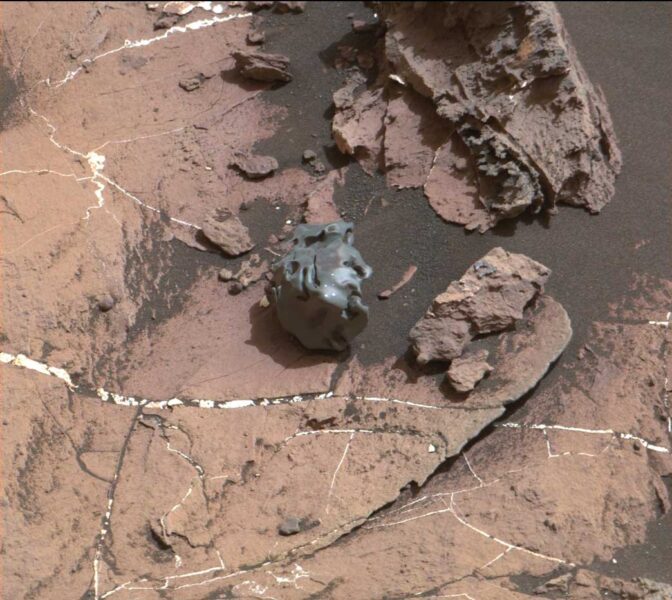NASA’s rovers have found meteorites on Mars that came from elsewhere. What secrets do they hold about Martian history and climate?

NASA / JPL-Caltech / MSSS
When the Opportunity rover discovered the first extramartian rock in May 2004, it seemed like such a delightful novelty. To travel all that way from our home planet to explore the Martian hills, dunes, and craters only to stumble upon a rock that is not from that world! What are the chances that among all the places we could have roved we’d roll right up to this interloper on Mars?
The chances are not all that poor, as it turns out. Between Spirit, Opportunity, and Curiosity, we’ve so far encountered more than 20 of these aliens. How did Opportunity recognize that first outsider? It has the look of many iron meteorites on Earth — shiny, metallic, and eroded with vesicles, or pits.
Astute observers noticed that, strangely, these rocks seem to have the same infrared spectrum as the Martian sky. Their shiny, metallic surfaces act as mirrors, reflecting sky light back to rover instruments. Once scientists correctly interpreted this, the spectra became a tool to find more meteorites.
Most meteorites we’ve spotted on Mars are iron or stony iron. On Earth these make up about 80% of finds but only 6% of witnessed falls, most of which are stony meteorites called chondrites. So far we’ve found no chondrites on Mars. Therein lies a mystery that we’re still trying to work out.
Our rovers have collectively logged only about 95 kilometers (60 miles) on Mars, and we’ve discovered an average of about one meteorite every 5 km. That would be ridiculous luck on some random drive on Earth, even in deserts akin to the surface of Mars. Has some process concentrated meteorites in the regions the rovers have explored?
Our own planet has places that naturally concentrate meteorites. In Antarctica’s Alan Hills, for instance, the flow of ice acts like a conveyer belt, depositing old rocks in a relatively small area. Could something similar have happened where our Mars rovers have made their meteorite sightings?
I asked my colleague Barbara Cohen (NASA Goddard Space Flight Center), who has led the effort to catalog the meteorites seen on the Red Planet. (They’re now listed in the official database of meteorites at lpi.usra.edu/meteor.) The surfaces where both Spirit and Opportunity roamed are deflationary, Cohen told me. “It’s similar to the Sahara Desert, where meteorites fall onto sand dunes, then as the dunes blow away you get these lag deposits of meteorites.” The dryness preserves them for hundreds of millions of years. To get similar concentrations on Mars, she said, “you have to infer that both things are in effect — there’s a way to concentrate them and a way to preserve them.”
Could the relative lack of stony meteorites we’ve found on Mars, at least so far, simply be because irons resist erosion better? Perhaps, but Cohen notes that chondritic meteorites might not stand out as well from Martian rocks and thus might have escaped notice as the rovers passed by. Or maybe Mars, being farther from the Sun and closer to the asteroid belt, receives a different mix of space rocks.
Further examination of these fortuitous finds on Mars has revealed that multiple erosional processes have affected their surface chemistries, including some modification by water. These and other meteorites may therefore become important probes of Martian history, even climate change.
This article originally appeared in print in the September 2020 issue of Sky & Telescope. Subscribe to Sky & Telescope here.
 0
0
Comments
You must be logged in to post a comment.